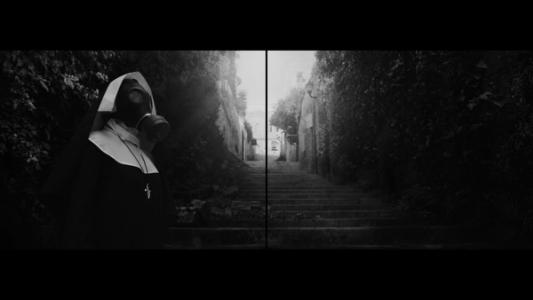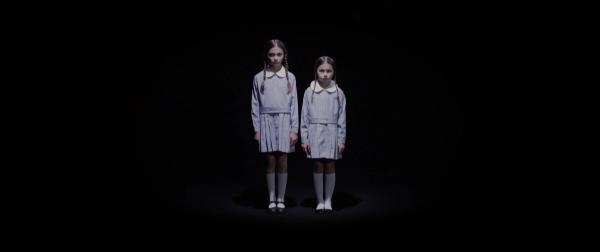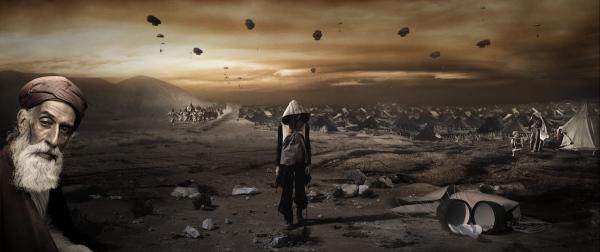
Larissa Sansour
Renowned Palestinian interdisciplinary artist, Larissa Sansour was born in East Jerusalem and studied fine art in Copenhagen, London, and New York. In film, photography, installations, and sculpture, Sansour’s work explores the intricacies of memory, time, trauma, diaspora and exile. Employing myth and historical narrative as a praxis, Sansour questions our relationship to artefacts and identity, the past, present and future. By combining political commentary and alternative universes, Sansour has honed the limitless possibilities of the sci-fi genre to awaken a potent expression of Palestinian Futurism that dissolves barriers of apathy and delves into futures grappling with grief, climate catastrophe, and collective amnesia.
Sansour’s work was exhibited in the Danish Pavilion at the 58th Venice Biennale and at the Guangzhou Triennial, China, and has been seen in galleries including New Art Exchange,Nottingham; Nikolaj Kunst, Copenhagen;Turku Art Museum,Finland;Depo,Istanbul; Tate Modern, London; Centre Pompidou, Paris; LOOP, Seoul; Barbican, London; and Haus der Kulturen der Welt, Berlin. She has had recent solo shows at the Whitworth Gallery,Manchester;KINDL, Berlin; Copenhagen Contemporary, Denmark; and Dar El-Nimer, Beirut.
Larissa Sansour’s most recent work, Familiar Phantoms, which premiered at the Copenhagen International Documentary Festival in March 2024, explores the nature of childhood memories and exile, and the often anomalous references the mind gathers to connect self, place, and belonging. Familiar Phantoms excavates the nature of personal and collective memory, probing at imagined or true recollections of history. The film articulates the psychological state of those displaced by occupation, specifically children who experience this form of violence and exile. The film creates a sense of empathy in the viewer for people who have fled Palestine and explores ideas of future trauma.
‘I was born in Jerusalem and grew up in Bethlehem, which is 15 minutes away. I had to leave Palestine during the First Intifada in 1988 [at age 15]. After Israel built its apartheid wall that separated Jerusalem from Bethlehem, it became impossible to travel to Jerusalem with a West Bank ID without a permit. It is also very hard to get a permit from Israel.
When I finally got a permit to enter Jerusalem after 15 years in 2020,I realized that I had somehow renegotiated my memories of the city of my childhood and had retrofitted them to my present political reality. I had somehow repressed memories of the city and treated them as unacceptable lies.’
‘In my latest film, I question the true value of memory, and how much of our memories are our own and how much are stories told to us. How much of our narrative is based on fiction and how much on reality, and where does the line lie between individual, collective, and state memories? In the film, it is the displacement from the place of origin and renegotiated geographies, that suddenly become real with my last visit to Jerusalem, and reinstates itself.’

Did your return to Jerusalem and your childhood memories influence the creation of this film? How did this experience enhanced your understanding of your connection to place and your childhood?
Yes, it was what inspired Familiar Phantoms completely. This film would not have happened if I had not had that moment, but it also affirmed that I have unprocessed trauma related to the place. It seems I have subconsciously decided to sever my relationship with the city as a protective mechanism.I guess that is what ethnic cleansing does it erases one’s proximity to the land and with it erodes language and memory.
In Familiar Phantoms, the transfer of one person's lived memory to a vivid shared memory is mentioned quite explicitly. It’s about how the lines blur between an individual’s lived experience and meld into becoming something felt and lived by others. This links to your previous works such as In Vitro and also expands into the symbolism reinforcing memory and legacy that you explore in your sci-fi trilogy Space Exodus, Nation Estate, and In the Future, They Ate From the Finest Porcelain. What influenced your transition into film and from documentary to fiction filmmaking, particularly your use of science fiction? How does your use of sci-fi allow you to navigate and comment on the complexities of the Palestinian narrative, including the interplay between past trauma, present struggle, and the conception of a possible future?
I started being drawn to film around the time of the siege of Bethlehem in 2003. I was in New York and frustrated by the discrepancy between mainstream media and what I knew was happening on the ground from friends and family. I saw my parents’ house in Bethlehem on the news. It is a strange feeling to see such a local reality be part of a major political escalation, but also to be so far away from it. I guess that’s how it always was and still is in Palestine. I spoke to my mother over the phone daily and I know her experiences were very different from the biased picture I saw on mainstream Western news. It became sadly clear that the onus was on Palestinians to shed light on a different narrative, and that’s what I’ve tried to do in my work. First and foremost, I wanted to document places that I thought were about to disappear. It was very important for me to include my family and myself in my films. Almost as evidence that cements that we’re not a myth, that we as a people and these places exist. Working with experimental documentaries was quite limiting, I felt. I needed to find a way of subverting the form by which we often tell stories of Palestine and of the marginalized. I felt I needed to flip the roles of the analyser and the analysed. I wanted my films to generate more than empathy. Science fiction allows me to build my own realities and work with various temporalities. Although quite unorthodox, I think futurism is a great tool for exploring Palestinian trauma. In a sense, futurism in a sense is stuck in our past understanding of futurism; our notion of futurism somehow always tends to look the same.
‘I feel the retrograde nature of futurism sits very comfortably with the Palestinian psyche; we are stuck in the past, the expulsion of Palestinians from our land in 1948, and we’re constantly projecting a future, for a future Palestinian state. But, the present is slowly disappearing. We are stuck in limbo, in a waiting room. The ability of futurism to look at the past and present from a different vantage point is very poignant in the case of understanding the Palestinian trauma.’


How does your sci-fi film In Vitro reflect the ongoing struggle of Palestinians caught between the historical trauma of the Nakba and the uncertain vision of a future Palestine? Can you expand on how the film explores themes of diaspora and mourning?
In Vitro is a film that depicts Bethlehem after an apocalypse, where a small number of people have managed to escape and build themselves a shelter underground. The underground becomes a metaphor for this time of limbo, of waiting for the earth to heal and become habitable again. The film is centred on an intense dialogue between a dying leader who has lived on Earth and a clone of her daughter who was born underground and has never seen the face of the Earth. The film addresses proleptic mourning and predictions of futures based on our present reality. The film was completed in 2019 for the Danish Pavilion at the Venice Biennale, but it is eerie to see it today in the context of the genocide in Gaza. In Vitro is a generational film as well and examines the inherited trauma of the diaspora. Dunia, the dying leader, believes that past traumas need to be preserved so that future generations can build a better future, whereas Alia, the clone of her daughter, is resentful of the fact that her present is seen as nothing more than a purgatory, a corridor between the past and the present. She also questions the necessity of her carrying the burden of the trauma of previous generations.

Can you discuss the politicization of archaeology and the significance of artefacts in your films Nation Estate and In the Future, They Ate from the Finest Porcelain?
Nation Estate is an ironic take on a future Palestinian state: a skyscraper with various floors that conveniently recreate the land, cities, and towns lost by Palestinians. It contains no checkpoints and you can move from one city to another in an elevator. Yet the building is still controlled by Israel and surrounded by the Israeli wall. The building is modern, clean and sterile, and you can see various Palestinian icons in it, like the Palestinian flag, the key signifying the right of return, the olive tree, embroidery, and so on. I wanted to present these objects as dead artefacts in a museum-like environment. A lot of Palestinians’ signifiers and symbols take on an elevated role in a culture that is constantly facing erasure. In the film, In the Future, They Ate From the Finest Porcelain, I wanted to reactivate these symbols. I was looking for an object that could function as Palestinian cultural DNA. I decided to use plates with the pattern of the Palestinian DNA for an archaeological project. These plates already featured in Nation Estate, and were made specifically for that film. There is a scene of me eating from these plates on the Bethlehem floor of the skyscraper. In the Future, They Ate From the Finest Porcelain, the main protagonist, a rebel leader, who calls herself a narrative terrorist, decides to bury these plates in various parts of Palestine and Israel for future archaeologists to excavate. By depositing these artefacts, she hopes to change the course of history and narrative. The film explores the role of myth in history, fact, and national identity.

Søren Lind, the co-director of the film also joined me in another project, Archaeology in Absentia, for which we produced more of these plates and buried them in 15 different parts of Palestine and Israel. The coordinates of where the plates are buried are in 15 different Fabergé egg-like sculptures that often get displayed alongside the film. The idea is that a museum that has the egg has the responsibility of replacing the deposits if they get damaged, therefore challenging the museum’s role in not only preserving the past but also the future. In the absence of a real peace process, archaeology has long since become a method for settling land disputes, and the discipline has long since lost its innocence as a sub-branch of historical studies. This work takes that instrumentalization a step further by not only suggesting a reinterpretation of historical artefacts but also by planting artefacts for future interpretation. At its core, this intervention takes on the very foundations of writing history and the possibilities of rewriting and influencing it.

How does the contemporary landscape marked by a sense of fear and a lack of accountability, underscore the responsibility of artists to challenge mainstream narratives, particularly in addressing issues of censorship and holding those in power accountable for their actions?
We live in really scary times. The clamp down on freedom of speech and expression is astounding, especially when it comes to Palestinian and Palestinian voices. At the same time, the hypocrisy of Western world leaders is too blatant for the majority of us to ignore. What is most concerning is that many cultural institutions are staying silent and following their governments’ line of thinking.
'I would think it is our role as cultural workers to hold people in power accountable and to keep them in check. We need to keep producing counter-narratives, otherwise those in power would succeed in silencing all opposing voices, not only those of Palestinians.’

Born in East Jerusalem, Larissa Sansour studied Fine Art in Copenhagen, London and New York. In film, photography, installations, and sculpture, Sansour’s work explores the intricacies of memory, time, trauma, diaspora and exile.
Interview by Melanie Pyne